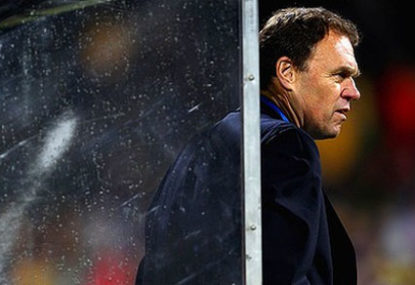HuyanHammer
new author
Roar Rookie

In the lead up to World Cup 2006, Nike ran a series of advertisements featuring the Socceroos.
In one ad a decrepit old man, named History, heckled the ‘Soccerwhos’. A player responded by belting a ball at him to comical effect. It was a challenge: time to prove history wrong.
What transpired during the World Cup was a fantastic showing by our national team, led by some of the finest players to ever play for Australia: Harry Kewell, Mark Viduka and Tim Cahill.
The 3-1 win against Japan was arguably Australia’s greatest ever achievement on the football field – particularly because we came from 1-0 down to snatch victory from the jaws of defeat.
The win put Australia in a commanding position to qualify from a fairly tough group that also comprised Brazil and Croatia.
The two teams on that fateful day were relatively evenly matched, but I would have said our star players tipped it in our favour ever so slightly.
Japan had Hide Nakata, Shunsuke Nakamura and Shinji Ono, but we had genuine Premier League stars in Kewell, Viduka and Cahill.
Lucas Neill was also playing regularly in the Premier League at that time, as was Mark Schwarzer.
Unfortunately, since that time the Japanese team have gone from strength to strength. They’ve been blooding young players, and one suspects they have been able to refresh their national team so effectively because of good grassroots-level technical development.
On the other hand Australia is still relying on many of the players we called upon six years ago – and we are much poorer for it.
Of the Australian players who played in that match against Japan in 2006, Kewell, Cahill, Neill, Schwarzer, Mark Bresciano, Brett Emerton, Luke Wilkshire and Josh Kennedy are still in the mix when it comes to selecting an Australian squad.
All of them are over the age of 30 and, with the exception of Schwarzer, none of them play in a top-tier European league.
None of the players who played for Japan are still in contention for their national team. Instead they have introduced rising stars like Shinji Kagawa, Keisuke Honda and Makoto Hasebe.
The difficulty for Australia has been finding replacements for these stars of yesteryear. I’m sure if we had a Shinji Kagawa, or even a raw talent like Ryo Miyaichi, they would be selected in a heartbeat.
The argument, however, is that the talent coming through the ranks is thin.
While we have shown a reluctance to blood players early – Chris Herd anyone? – this is only part of the problem. We actually do not have any players of high technical merit coming through the ranks.
In the time Japan has produced an entirely new team, decorated with players of skill and poise like Kagawa and Honda, Australia has not turned up a single player anywhere near the calibre of Kewell, Viduka or Cahill.
Japan’s production line shows no sign of slowing down with the likes of Miyaichi coming through. The reason is simple: as a footballing nation we are far inferior technically and structurally.
Half of the current Japanese squad play in the J-League. Of the players who have moved to Europe, virtually all of them plied their trade for a few solid seasons in the J-League before the move.
There are various reasons why J-League football is of a higher level than the A-League. You only need to watch a game or two to realise we are streets behind.
We can talk about Japan having more sponsorship money, a larger population, and even patriotism. The nationalistic sentiment of Japanese people probably plays some part in players wanting to stay and give back to the league that has made them successful.
Regardless, as a sporting nation we have never made excuses as to why we cannot compete. Our 22 million people perform admirably every four years at the Olympics and our population is a fair bit larger than the Netherlands, a football powerhouse.
In the end our failure to develop technical players reflects one thing that needs to change: our attitude towards what makes a good footballer.
There are some words that you hear far too commonly while watching a game of grassroots soccer: ‘Smash him!’; ‘Run hard!’; ‘Get there!’; ‘Win the ball!’
From a very young age Australian kids are taught by coaches and parents to run hard, play hard and generally toil for the ball.
How utterly boring.
As a kid I never played football for the crunching tackles or to shoulder someone off the ball.
My idols were not the Stuart Pearces or Paolo Monteros of the world – who the hell are they? Exactly.
My idols were the Roberto Baggios, the Rivaldos and now they are Iniesta and Messi. These are players with grace and skill and courage. They don’t have the desire to chop someone down, but to ride that tackle and keep on going. So it is with most kids and adults.
I met a Japanese player at a recent futsal trial. In regard to the Australian game, he delivered a similar assessment.
“I am very surprised at the Australian style,” he said. “It is so hard, players hit you so hard. It is very strange.”
“In Japan it is not the same; in Japan we focus on passing.”
I cannot help but think there is something within the male Australian psyche that causes us to revel in being described as ‘hard’.
It is not a compliment. If we are to produce another Kewell, who is probably one of only a handful of technically gifted players Australia has ever produced, we need to change our way of thinking and prove history wrong.
In the Nike ad six years ago, the catchphrase was ‘Joga Bonito’. Old man History asserted that Australia could not play the beautiful game.
It was and still is a challenge. And it’s time to rise to it.